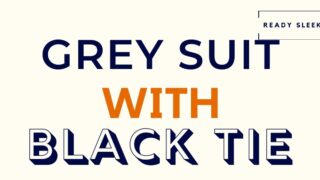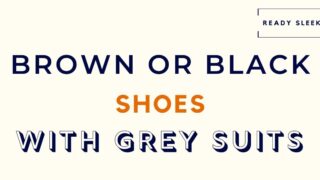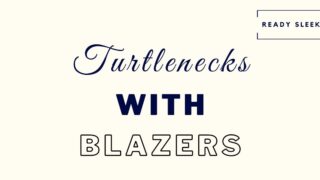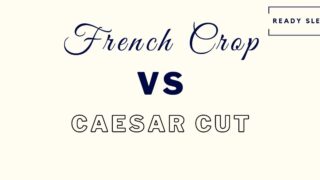There are few dress codes as confusing as “business casual”. It can mean many different things depending on who you ask and where you ask it.
When it comes to choosing a pair of pants for the occasion, the same frustration and confusion often comes into play.
Consider this a resource you can use to help decide whether or not your pants could ever meet the business casual cut.
Whether it’s for an office party or a summer soiree, underdressing for an occasion is never a good experience.
I’m going to go through very specific types of pants (trousers): the best and the worst options for the elusive business casual dress code.
Let’s get to it.
What Exactly Are “Business Casual” Pants?
Business casual pants are those that are easy to combine with traditional items of business attire such as shirts, neckties, and dress shoes, without being part of a full suit. They fit well into ensembles that strike a balance between casual and professional.
If you wanted to keep things simple when it comes to business casual you’d do well by merely sticking to two rules – no jeans and no full, matching suits.
But to get a better understanding, it’s worth getting to grips with what the term “business casual” really means.
It’s best to think of the term “business casual” as a spectrum.
This spectrum ranges from a casual end to a more formal end. A “business casual” dress code can vary according to the workplace or the event.
Even if a workplace has “business casual” as their dress code of choice, that term can actually vary according to the day-to-day activities within the job role.
For example, an office manager who attends regional meetings may need to wear business casual attire on the more “formal” end of that spectrum. Dress pants and a blazer would be more appropriate.
But for his everyday desk job, a sweater and a pair of khakis may be perfectly fine. In other words, items on the more “casual” end of the business casual spectrum.

What about non-office environments? Let’s take a summer conference with a business casual dress code as an example.
A blue houndstooth blazer would work great, but it may be considered too “casual” for an office environment, even if it had a “business casual” dress code as well.
My point here is – it isn’t quite as simple as saying certain types of clothes are always business casual while some others never are.
Having said that, classic business casual items include chinos, OCBD shirts, sweaters, sports coats, blazers, and Derby shoes.
Keeping some contrast between the pants and the clothes above the waist (shirt/sweater/jacket) is important when it comes to business casual.
That means contrast both in terms of color and texture. This is the key to distinguishing it from business professional suits.
Also, always tuck the shirt into those pants. An untucked shirt will always come across as too casual for business casual.
Keep things simple.
Here are some key principles to take away:
- One man’s business casual is often different to another man’s business casual.
- A single person’s “business casual” dress code can vary from one day to another, even in the same job.
- If in doubt – it’s better to overdress. Business casual is still more “business” than “casual”.
- Even if the pants are considered “business casual appropriate”, if the other items you wear them with aren’t, it doesn’t even matter.
- Features that make the pants look more like jeans – like rugged texture, metal tacks/rivets, and prominent seam details – often make them look too casual for business casual outfits.
- The more pockets a pair of pants has, the more casual it’ll look. Having many pockets, especially patch pockets, will most likely make them look too casual for business casual.
Now, let’s talk about more specific pants, one by one.
The Best Pants For Business Casual
Here are the best and most appropriate pants to wear for business casual dress codes. What sets them apart is just how simple they are to combine with both professional and casual items.
Khakis
Khakis work exceptionally well for business casual dress codes. They strike a remarkably fine balance between formal and casual and are easy to combine with items of business attire such as shirts, blazers, and neckties.

Although “khaki” is technically a color and not a style in itself, the term is generally used to refer to khaki-colored chinos.
They grew wildly popular in 1980s corporate office culture, with brands such as Dockers leading the charge.
Since then, they’ve made their way into everyday casualwear and show no sign of fading in popularity.
They look more formal than jeans but not quite as formal as woolen dress pants. This really does make them ideal for smart casual and business casual settings.
They’re made from the durable cotton twill chino cloth. It’s comfortable and also relatively wrinkle-resistant.
While it’s hard to go wrong with wearing khakis in business casual outfits, there are certain features that make some khakis look more formal than others.
If you want to play it safe, go for a more formal-looking pair of khakis if possible. Remember, business casual dress codes should always be considered more business than casual.
It’s better to overdress than to underdress.
Here are some features of khakis that are considered more formal than casual:
- Welted pockets instead of the more casual-looking patch pockets at the back.
- Center creases. It’s less common with khakis than with dress pants. But khakis with center creases down the pant legs can look very smart indeed.
- Seam details. More formal-looking khakis often have less obvious seam details. Remember, if the seams remind you of jeans, they probably look more casual than formal.
Remember these principles and you’ll be fine. Items that work great with khakis in business casual outfits include blazers, sports coats, OCBD shirts, dress shirts, neckties, and sweaters.
Slacks (Dress Pants)
Slacks (a.k.a dress pants) can be business casual if the other items they’re worn with don’t come across too formal. Wearing slacks as part of a suit-separate (spezzato style) works well as business casual attire.
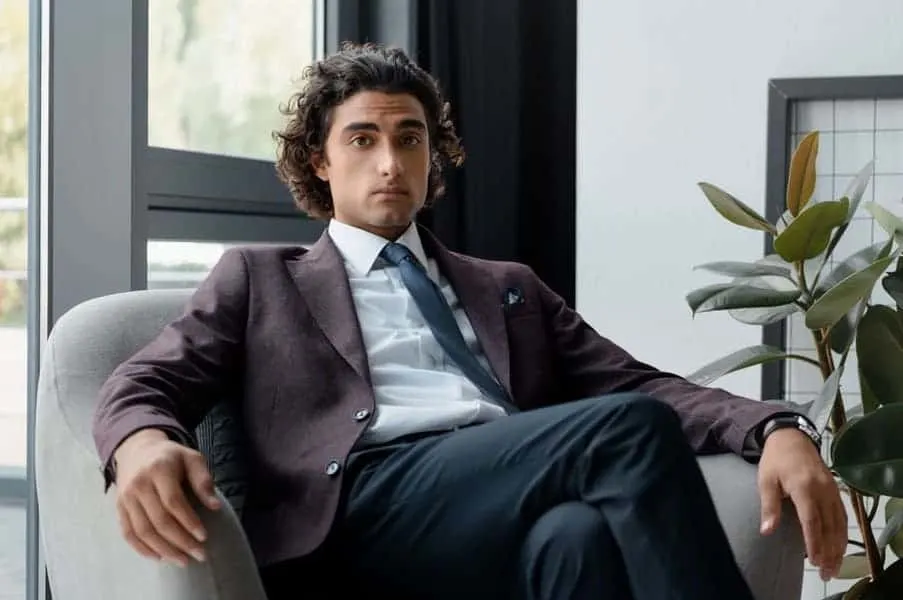
[From Deposit Photos]
“Slacks” is simply an old-fashioned term for “dress pants”.
They are usually made from a smooth wool or wool-synthetic blend. Worsted wool is one of the more formal types you’ll come across and is commonly used for formal attire.
The danger with trying to wear slacks as business casual dress is that it comes across too formal.
Slacks often look formal because the wool is usually quite shiny and also wrinkle-resistant. The cut is usually fitting and there will often be a center crease – a classic feature of formal pants.
Does that mean slacks can’t be worn as business casual?
Not at all.
Business casual is a spectrum. There will be business casual settings where you may want to go for a more “formal” outfit on the business casual spectrum.
Those slacks might look a little too formal for a summer garden party, but they may be absolutely fine for speaking at a conference, for example.
Both events may have “business casual” dress codes, but one of them would probably expect more formal attire than the other.
The key to ensuring that the slacks don’t come across too formal and do come across as “business casual” is combining them with the right items.
Slacks often come as part of a suit with a matching blazer. It’s OK to wear them together, but doing so with a dress shirt and tie would just look like a business suit.
This isn’t business casual.
But what if you ditched the tie and undid one or two buttons of the shirt? What if you ditched the black Oxford shoes and chose a pair of brown penny loafers instead?
All of a sudden, your matching suit looks a lot more “business casual” and a lot less formal.
Either way, wearing a matching suit jacket and trousers will never be ideal for business casual, but it can work.
A better option for business casual is spezzato style. This involves matching the jacket from one suit with the slacks of a different (but complementary) suit. This is also called a “suit separate”.
It isn’t easy to get right, but when you do, it’s a great way to wear slacks as business casual.
People often wonder whether it’s OK to wear slacks without a jacket whatsoever. For example, a pair of slacks and a shirt, but no matching blazer.
Unfortunately, slacks can look sort of incomplete without a jacket of some sort. It’s usually easy to tell that a pair of slacks should have come with one – the material just looks too formal not to.
It’s possible, but not advisable.
Ultimately, the best way to wear slacks as business casual would be in spezzato style or by dressing down the matching suit.
Corduroy Pants
Corduroy pants can be worn as business casual, especially in neutral colors and straight leg fits. Flared, baggy, and wide leg corduroy pants in brighter, more vibrant colors are harder to wear as business casual.
The rugged fustian fabric of corduroy pants does come across as quite casual at first glance. But it’s a versatile material that does work well in semi-formal settings as well.
Here’s an example of a pair on

Corduroy pants tend to go hand-in-hand with sports coat and sweater combinations.
It’s a look that’s bound to draw some comparisons with liberal arts professors from the 1970s, but it does have a pretty natural business casual vibe to it.
Nowadays, although they’ll always come across as “retro” to a certain extent, there are certain features of corduroy pants that tend to make them look more modern.
These features also seem to make them look less casual and more business casual, funnily enough.
Color is crucial.
While colorful and in-your-face corduroys may have been all the rage back in the 1970s, they won’t be appropriate for business casual.
Stick to neutral colors such as brown, tan, beige, khaki, white, and navy blue to play it safe.
Corduroy pants with patch pockets will also tend to come across too casual as well. Stick to welted or jetted pockets if possible.
The fit is also extremely important.
Wide leg and flared corduroys will look too retro and too casual for business casual. Go for a straight leg fit and you should be fine.
Finally, as always, pair the corduroy pants with the right attire to make sure it doesn’t look awkward in business casual settings.
Sports coats, sweaters, Oxford shirts, and brogue Derby shoes or loafers would all be worth considering.
Golf Pants
Golf pants can be worn as business casual, especially those that are made from cotton twill, have a slim fit, and fewer pockets. These chino-esque features would allow a pair of golf pants to fit seamlessly into a business casual outfit.
You could argue (successfully) that cotton twill golf pants were just stretchy khakis.
Here’s an example of a pair of Dockers on

But given the variety of golf pants out there, it’s important to get it right. Not all of them are made equal and some styles would be inappropriate for this tricky dress code.
In fact, most golf pants are actually made from polyester – these would usually be inappropriate for business casual outfits.
In contrast to cotton twill, polyester golf pants generally have more sheen and a more relaxed fit to allow for more agility and ease of movement on the green.
It’s why polyester is so popular with sportswear in general – it optimizes for performance, but not necessarily for style.
The sheen and relaxed fit of polyester golf pants would make them look too sporty and casual to wear in a business casual outfit. They would just look strange when paired with a dress shirt and blazer, for example.
So, stick to cotton. There’s very little that separates a pair of cotton golf pants from a regular pair of chinos. In fact, there are some who would argue that there’s no difference at all.
But cotton golf pants often include just a small amount of elastane to give it some stretch.
This should give you a little more freedom of movement – more so than a regular pair of chinos but definitely not as much as a polyester pair of golf pants.
Either way – they will still look very similar to chinos and we all know that chinos work great for business casual outfits.
The fit you go for is also important.
Although regular fit golf pants would most likely be fine, a slim fit with a narrower leg width, narrower cuffs, and tapered legs would be better. They come across as less casual and more business casual.
Golf pants with pleats also come across as more formal – if yours have them, great.
Finally, it’s quite common for golf pants to have an extra couple of pockets – sometimes up to 6 – to help hold your tee’s glove and scorecard.
While this is extremely practical and useful from a sporting perspective, it does make the golf pants look less appropriate for business casual outfits. Stick to regular golf pants with two front pockets and two rear pockets to play it safe.
Tech Pants
Tech pants can work well in business casual outfits as long as the style they resemble is appropriate. Tech chino pants and tech dress pants often look formal enough to be included in business casual attire.
It’s important to understand that “tech pants” are simply pants that have been designed using a blend of fabrics and synthetic materials that give them features of resilience.
Water repellency, wrinkle resistance, stain resistance, and stretch are just some of the features they often try to achieve.
This makes them low maintenance and practical to wear.
But the term “tech pants” doesn’t say anything about the style they look to replicate. For example, you can get tech pants that look like chinos – often a cotton-synthetic blend.
Here’s a pair of tech chinos on

Or, you can get tech pants that look like jeans, cargo pants, or other workwear.
As you’d expect, the more formal-looking tech pants would be a lot more appropriate for business casual outfits than the more casual-looking ones.
If you’re trying to put together a business casual outfit and you’re working with OCBD shirts, sweaters, neckties, and dress shoes, a pair of tech jeans simply wouldn’t work.
They’ll look too casual. In fact, “no jeans” is a key principle behind the business casual aesthetic, whether or not you’re working with “tech jeans” or regular jeans.
On the other hand, tech chinos and tech dress pants (often made from a wool-synthetic blend), would most likely look formal enough to wear in business casual outfits.
They resemble these smart-casual/formal pants but still retain the resilient properties you’d look for in tech pants.
This is ideal.
The Worst Pants For Business Casual
Here are some pants you definitely want to avoid when dressing business casual. It simply isn’t worth the risk.
Joggers
Joggers can never be considered business casual, regardless of what they are worn with. They are simply not formal enough and are far more appropriate for casual wear or sportswear.
“Business casual” should always be thought of as a blend between formal and casual.
To an extent, this does mean that you take some items from typical formalwear and some from typical casual wear, and you kind of mash them up together.
But there are limits.
There are some items that are so far along the “formal” end or the “casual” end of the spectrum that they could never be reasonably included in a business casual outfit.
A bowtie is a good example – it’s just way too formal to be included.
When it comes to pants, joggers are a great example of pants that just look too casual to be included in a business casual outfit.
The loose cut, rugged fabric, and elasticated waistband all ooze casual – as they’re supposed to.
They’re ideal for casual wear, streetwear, and sportswear. They’re comfortable and allow you to move with ease and agility.
But even if you were to combine those joggers with a shirt, it just wouldn’t work for business casual attire. In fact, it would look downright weird.
So, when it comes to business casual dress codes, avoid joggers at all costs.
Cargo Pants
Cargo pants are not suitable for business casual attire because they simply look too casual. This is due to the baggy fit, the numerous patch pockets, and the large belt loops.
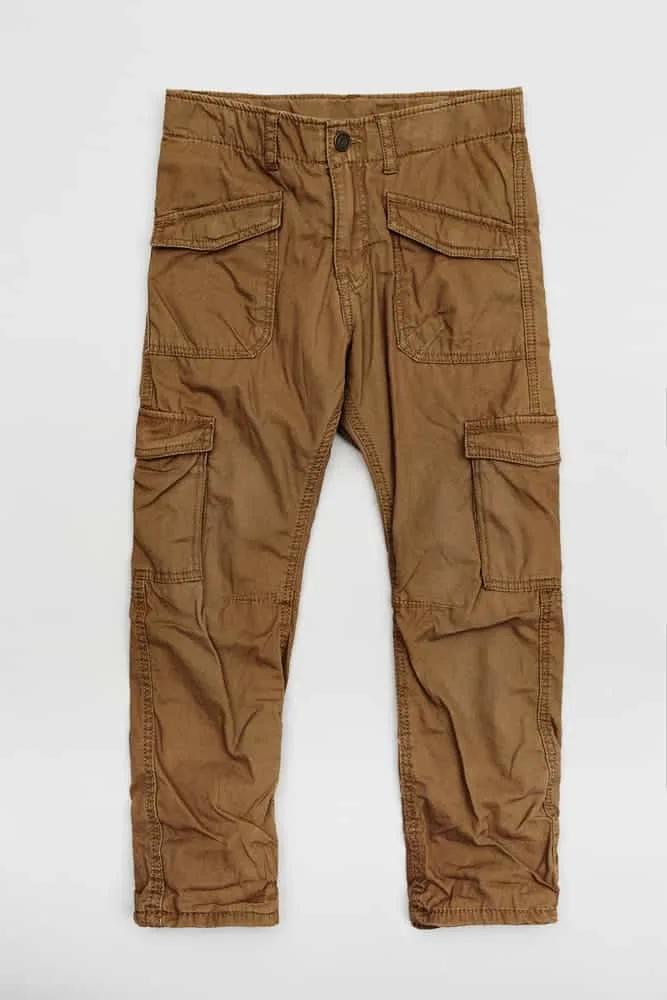
They make for ideal workwear or casual wear, especially when you need to carry a bunch of things around and need large-volume pockets to do so. This is when cargo pockets become invaluable.
The loose fit is comfortable and allows for agility, easy movement, and easy bending at the knees and hips.
The fabric used is sturdy and durable, often made from weather-resistant synthetic fabrics or cotton-synthetic blends.
But cargo pants are not suitable for business casual dress codes.
A lot of the features that make them great in terms of utility and workwear make them look pretty informal.
Although business casual outfits can and should include some semi-casual items – there’s a limit.
There are certain items that are simply too casual to include and cargo pants would be one of them. They’d simply look too strange combined with traditional business casual items like blazers, sports coats, or Oxford shirts.
This would be the case no matter what color they were or what fabric they were made from. There’s really no way to make them work.
So, keep things simple and avoid the risk.
5 Pocket Pants
5 pocket pants are generally not considered business casual. The prominent pockets, metal tack buttons, and jeans-esque fit often make them look too casual to be worn in business casual outfits.
This may be controversial, as there are likely plenty of people that do wear 5 pocket pants in these dress codes.
But when you really break it down, you realize how it’s probably not a good idea.
If you were going to distill “business casual” into two basic rules, the following would be reasonable:
- No (matching) suits.
- No jeans.
Of course, there’s a lot more to it. But those two rules will serve you well.
5 pocket pants, no matter what fabric they’re made from, will always have a jeans-y appearance to them. They don’t necessarily need to be made from denim, although they often are.
Here’s a pair of 5 pocket chinos on

Because 5 pocket pants tend to look like jeans, they often appear to break one of the two cardinal rules of business casual I listed above.
They’re generally considered to be a dressier form of jeans, appropriate for occasions where jeans are too casual but chinos or dress pants may be too formal.
The problem is, 5 pocket pants always tend to look like jeans due to often having metal buttons, tacks, or rivets, as well as a fit that’s generally slimmer than that of the average pair of chinos or dress pants.
It’s also hard to ignore the pockets. As the name would suggest, 5 pocket pants have five pockets.
Two at the rear, one at each front hip, and an additional 5th pocket inside the right hip pocket.
Having this number of pockets just looks casual. It always will.
All of these features add up to an appearance more in line with the functional, workwear look that they were originally designed for by Levi Strauss back in the 1800s.
Leading on from that, the appearance just looks too casual to fit into a business casual outfit. In general, business casual outfits should still be more business than casual.
If in doubt – overdress. 5 pocket pants would put you at risk of underdressing instead.
If you were intent on wearing 5 pocket pants as business casual, be careful when it comes to the fabric.
5 pocket pants were traditionally made from heavier fabrics like denim. But there are 5 pocket pants that come in “dressier” fabrics like wool or cotton twill, making them look more like dress pants or relaxed fit chinos, for example.
The drape with these fabrics would be gentler and lighter than that of heavier ones, making them more formal looking and more appropriate to wear in business casual outfits.
But still, there’s no getting around the fact that no matter what fabric they’re made from there will still be 5 prominent pockets and most likely some metal tacks and buttons to boot.
To sum that up, avoid it if possible. You’ve got better options for business casual pants.
Linen Pants
Linen pants are not suitable for business casual outfits due to the baggy fit and wrinkled appearance. They simply don’t look formal enough to safely be worn in business casual outfits.
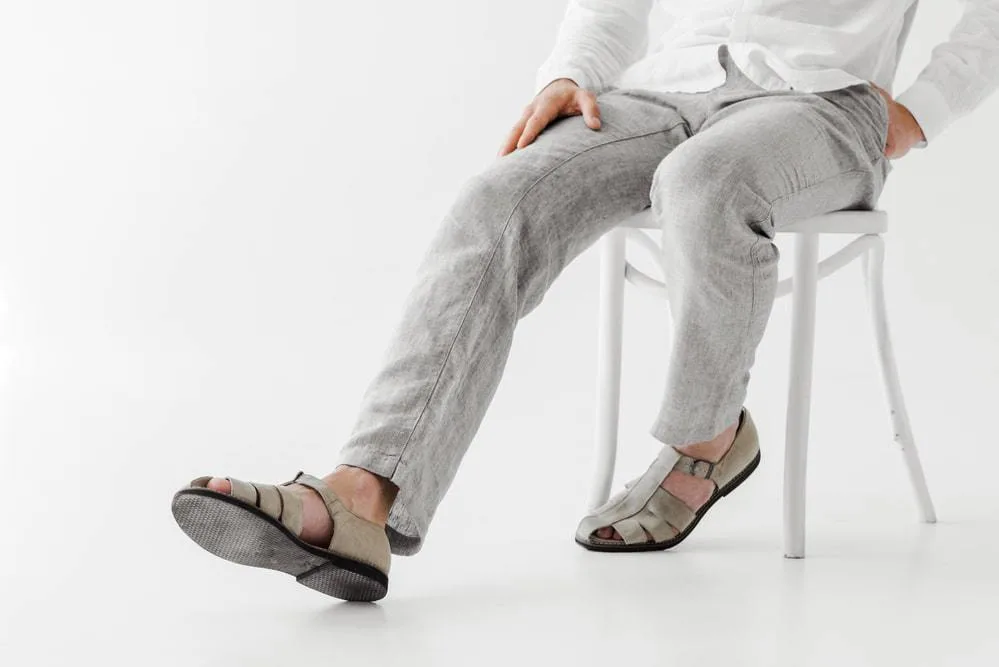
To understand why linen isn’t suitable for this dress code, it’s worth digging into what it actually is first.
Linen is a strong and sturdy fabric that has remained a popular choice for clothing due to being breathable, long-lasting, and eco-friendly to produce.
It’s been created from the flax plant for several thousands of years, often referenced as a sign of purity, royalty, wealth, and luxury in ancient texts.
In the modern world, it’s simply a summer favorite.
The porous nature of the relatively loose weave of linen makes it comfortable and breathable to wear in warm weather. It has heat and moisture-wicking properties as well.
Linen pants are no different – they’re extremely popular when the heat rises and cotton or wool just aren’t going to cut it.
But linen pants just look out of place when combined with business attire, as you would do when trying to cater to a business casual dress code.
The pants are often cut wide because linen doesn’t stretch much naturally. This often leads to a loose fit which can look more casual than you may want it to.
But the main reason that linen pants look too casual is simply how easily they wrinkle. The flax fibers that linen is made from don’t relax easily.
This makes them very likely to wrinkle and stay wrinkled.
While the wrinkly appearance of linen is actually considered an attractive feature in many respects, it does definitely make it look more casual.
More specifically, it makes it look too casual for business casual attire.
They’ll look out of place when combined with business items like Oxford shirts, dress shirts, neckties, and dress shoes.
Tactical Pants
Tactical pants should never be worn in business casual outfits due to their traditional workwear aesthetic. The multiple pockets, thick belt loops, and reinforcements make tactical pants highly inappropriate for business casual attire.
They’re similar to cargo pants but often have even bigger belt loops and also more reinforcement.
Tactical pants are perfect as outdoor wear for climbers, workwear for emergency technicians, law enforcement agents, etc.
The large, numerous pockets are ideal for carrying tools and the thick belt loops are ideal for carrying the weight of a utility belt.
Plus, there is often reinforcement at the knees and the rear for additional protection. Ultimately, tactical pants ooze utility and durability.
But they’re entirely inappropriate for business casual outfits.
There is no way they’d combine well with any form of business attire, whether it’s blazers, neckties, dress shirts, or dress shoes.
They simply look too much like workwear because that’s what they are.
Don’t make the mistake of using them for anything else.
Frequently Asked Questions
Here are a few other frequently asked questions on business casual pants I wanted to address in detail.
Are Cuffed Pants Business Casual?
Cuffed pants can be worn as business casual as long as the pants themselves are considered appropriate. Dress pants and chinos work especially well when cuffed and are perfectly suitable for business casual attire.
To “cuff” pants means to fold the bottom part of the pant fabric upward and outward so that the hem is rolled.
It makes the pants look shorter and prevents them from creasing at the bottom.
There are different types of cuffs, mainly varying in the number of times they’re rolled up. For example, a single cuff is rolled once. A double cuff is rolled twice.
The more times they’re cuffed, the shorter the pants will appear and the more the leg will show.
Ultimately, most types of pants can be cuffed – whether they’re casual or formal.
If you want to cuff your pants and wear them as business casual, the style of pants matters way more than the cuffing itself.
For example, jeans are commonly cuffed and this often looks great. But at the end of the day – they’re still jeans.
Whether they’re cuffed or uncuffed, they’re simply too casual for business casual outfits.
So, choose the right pair of pants – chinos or slacks, for example. Then, cuff them to your desire.
To play it safe, go for a simple single cuff. You don’t want too much (or any) or your leg showing if possible, as it will most likely look too casual for business casual dress codes.
A single cuff should rest gently on top of your shoe. Stylish, but still formal enough for business casual.
Are Twill Pants Business Casual?
Twill pants can be business casual as long as the specific type of twill fabric looks formal enough. Chino, tweed, and gabardine cloth are twill fabrics that are often suitable for business casual, while denim is a twill fabric that simply looks too casual.
“Twill” is a type of weave characterized by its diagonal lines.
It isn’t a type of fabric. There are many different fabrics that are woven in a twill pattern, all of which generally have a pretty durable finish.
The most popular twill fabrics you’ll come across are chino and denim. As you can see, very different fabrics can be woven using a twill weave.
So, if you’re looking to dress for business casual, consider the type of twill pants you’re going for.
Stay away from the more casual styles such as jeans – they won’t be appropriate to combine with business attire.
But chino pants are a type of twill pants that are definitely suitable for business casual and easy to combine with items such as Oxford shirts and sports coats.
Conclusion
Business casual will be a dress code that continues to confuse men for decades to come.
But decoding it isn’t as complicated as it may first seem. The world of business casual trousers is no different.
You’ve now got a much better understanding of how to choose the best style of pants for a business casual dress code with minimal risk of making a style faux pas.
Enjoy.
Ready Sleek founder. Obsessed with casual style and the minimalist approach to building a highly functional wardrobe. Also a fan of classic, vintage hairstyles.


